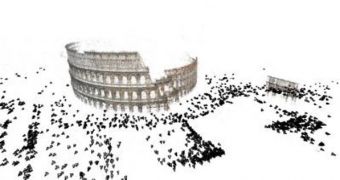Researchers at the University of Washington have recently developed a new series of algorithms that allows them to digitize the entire city of Rome in less than a day. Using a collection of hundreds of thousands of tourist photos, taken within the limits of the city, the new software can easily stitch them together, to create the most comprehensive digital view of the Ancient Roman metropolis. Though it took about ten years to build the Colosseum, and another century to construct St. Peter's Basilica, now they can both be digitized in less than 24 hours.
For their new model, the researchers went to the famous photo-sharing website Flickr, and took some 150,000 images tagged with “Rome” or “Roma.” It then took 21 hours for them to stitch the pictures all together, to provide the first virtual tour of the city, especially in the areas surrounding its most famous monuments. A viewer can “fly” around the Italian capital's landmarks, from the Trevi Fountain to the Pantheon to inside the Sistine Chapel.
“How to match these massive collections of images to each other was a challenge. [Until now], even if we had all the hardware we could get our hands on and then some, a reconstruction using this many photos would take forever,” UW Acting Assistant Professor of Computer Science and Engineering Sameer Agarwal says. The scientist is also the lead author of a paper detailing the methods the team used, which will be presented at the International Conference on Computer Vision, to be held in Kyoto, Japan, this October.
The photo software that the team used is a more advanced version of Photo Tourism, another algorithm that they licensed to Microsoft in 2006. The Redmond company now sells the technology under the name Photosynth. “With Photosynth and Photo Tourism, we basically reconstruct individual landmarks. Here we're trying to reconstruct entire cities,” Cornell University Assistant Professor Noah Snavely, also the co-author of the paper, explains. He has also been the expert who developed Photo Tourism as his UW doctoral work.
The new programming code can run faster and more efficiently than previous versions, and also has the ability to function on many computers at the same time. It can also function even on remote servers connected through the Internet, which drastically reduces the wait time. Photo Tourism, for instance, would take about a decade to stitch one million photos together on 500 computers running simultaneously. The new algorithms take 100 times less. “If a city reconstruction took several months, it would be just about building Rome. But on a time line of one day you can methodically start going through all the cities and start building models of them,” UW Computer Science Professor Steve Seitz, also a co-author, concludes.

 14 DAY TRIAL //
14 DAY TRIAL //